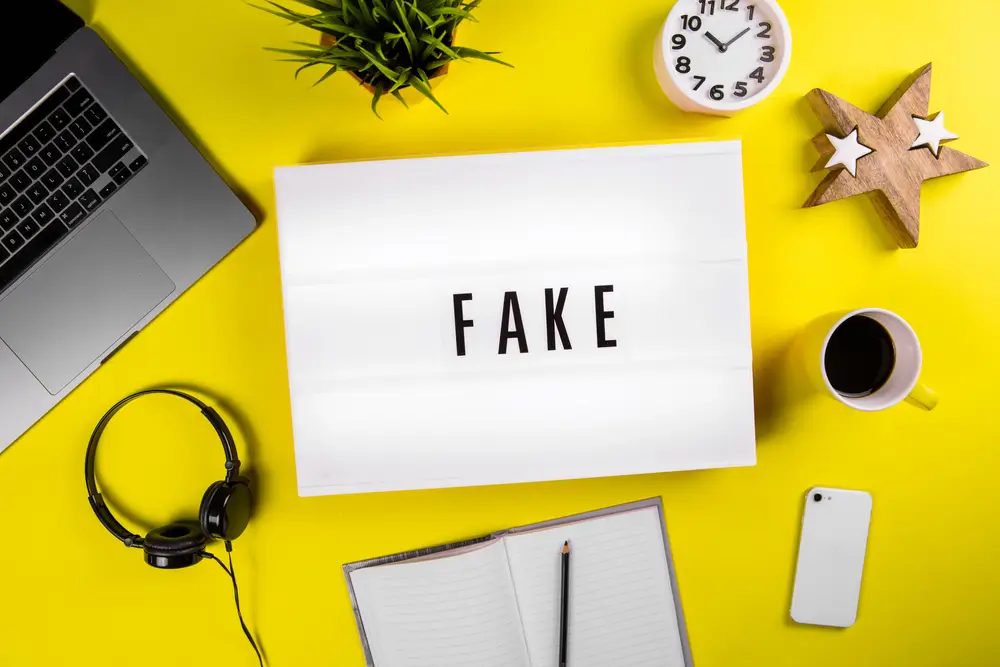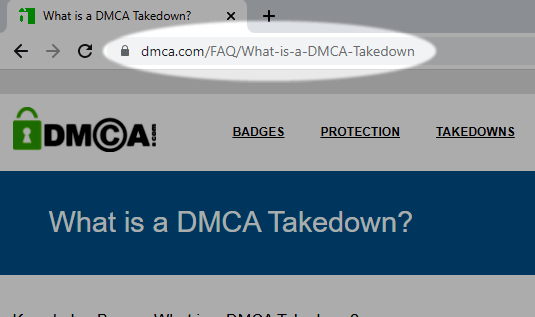
The main cause of fake DMCA Takedowns is overworked DMCA Takedown processors (who are often network admin) and the DMCA Safe Harbor which states clearly to follow the takedown to avoid liability. Using a supporting a third party DMCA Takedown Processor like DMCA.com or a lawyer goes a long way to solving a growing number of false DMCA.com claims. Supporting third party DMCA Takedown companies means these overworked people can trust the takedown has already received some scrutiny and should have a higher degree of truth.
DMCA.com's Compliant Program can help eliminate false or fake DMCA takedown notices.
Especially designed for ISP's, OSP, Webmasters and other online web companies. This program saves web-based organizations thousands of dollars on the cost of handling DMCA Takedowns. This service provides a complete DMCA "A to Z" DMCA service. Including submission forms and website documents. To get started see details here: Get Compliant
DMCA Takedown Fast Tip
Most websites, ISP's, OSP's, hosting companies have adopted the DMCA Takedown process to handle requests for the removal of illegally hosted content on websites within their control.
What kind of sites would possibly receive fake DMCA Takedown Notices?
Infringing content is taken down from many different websites and platforms. Here are some examples:
- from a UCG (User Generated Content) Platform (like Facebook and TikTok), upon receipt of a DMCA Takedown Notice sent by or on behalf of the infringed content owner, distributor, publisher etc.
- by the by the ISP or Hosting company of the website that is publishing the infringing content. This occurs because the website owner has not voluntarily complied with a DMCA Notice and the ISP or Hosting company must comply with the Takedown notice.
- when an infringing website is taken down or taken "offline" by its ISP or Hosting company. This occurs because the website owner does not voluntarily comply with a Takedown notice as described above.
- by the website owner, upon receipt of a DMCA Takedown Notice from the website owner's ISP / Hosting company. This would occur when ISP / Hosting company receives a notice sent by or on behalf of the content owner, distributor, publisher etc.
- by the website owner upon receipt of a DMCA Takedown Notice from the, or on behalf of, the content owner, distributor, publisher etc.
Who would possibly send fake DMCA Takedown Notices?
- social media users and participants
- content creators/owners
- copyright owners
- content publishers or distributors (with permission of the content or copyright owners)
- NFT owners
- code writers and publishers
- subject contained within the content and published without permission (special considerations may be required)
DMCA Takedown Testimonial
Dear DMCA.com, We recently had the unfortunate situation whereby our website was copied by an overseas business. The offending companies blatant copying of text and theft of images was not only a breach of copyright but was also having a negative impact on our SEO campaign and in turn our ranking within the search engines. Not knowing what to do or how to resolve the situation we found DMCA.com and after having lodged and paid for a 'Takedown' they acted immediately and within aprox 7 days they had the offending site taken offline. The entire process was very smooth and their communication was excellent. Hassle free service, great communication and they did what they promised. Money well spent...! Thanks again DMCA.com -Regards, Bill, Copywell Australia
How can I tell if it's a fake DMCA Takedown Notice?
A DMCA Takedown is when content is removed from a website or internet platform at the request of the owner of the content. The DMCA Takedown is a well-established and accepted internet standard followed by website owners and internet service providers everywhere.
Any owner of content has the right to process a takedown notice against a website owner and/or an Online Service Provider (e.g., ISP, hosting company etc.) if the content owner's property is found online without their permission.
If you receive a DMCA Takedown notice the first step is to remove the listed infringed content. If you believe the DMCA Notice to be false you can respond with a DMCA Counter Notice. Once the service provider (ISP/OSP) has received a valid DMCA Counter Notice/Counterclaim they must wait 10-14 days before they re-activate or allow access to the claimed infringing content. Unless the copyright owner (complainant) files a order in court against the infringing site owner, the defendant (ISP / OSP subscriber) and demonstrates the order to the ISP/OSP.
If you need to process a Counter Notice or Counterclaim, we can help. Click here to submit the form.
How can I spot a fake DMCA Takedown Notice?
Three main pieces of information are needed in each DMCA Takedown Notice, check that this information is provided to confirm the legitimacy of the claim:
1. Infringing URL(s)

Where on the internet or platform is the claimed stolen content located? What is the link that is asked for removal? Be sure the notices include the URL or website/webpage link of the content that is asked for removal.
An example link would look like: https://www.badguy_site.com/webpage/image_2

2. Source URL(s)
Where is it claimed the content stolen from? Was it on a social media profile, or was it from a website? The notice must show the exact URL where it was stolen from, even if the content has already been removed from its original location. The original URL is still valuable to the notice. If it is not currently available online it may reference cell phone, computer, or camera etc.
An example link would look like: https://share.icloud.com/photos/my_original_content
3. Description of Infringement

Who is claiming ownership of the content? Was it created, purchased, or copyrighted? What is the content owner's name and how was the content stolen? Who is authorized to file the DMCA Takedown? When was the content created and when was the content stolen?
An example description would sound like: "My photo I took of myself on my camera was stolen from my Google Drive and was posted on this website without my knowledge and I would like it removed."
If you are unsure how to collect the information for these three categories the Professional Takedown Team at DMCA.com can help with the answers. Click here to ask us about your situation.
Related DMCA Takedown FAQ's
- What is the DMCA Protected Badge

- What is Fair Use
- What is DMCA Protection
- What is DMCA Takedowns
- What is DMCA.com
- What is DMCA Protected Certificate
- What is DMCA Website Certificate
- What is DMCA Website Status Page and Protection Certificate